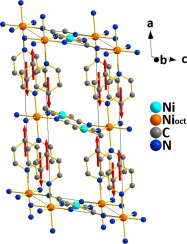当前位置:
X-MOL 学术
›
J. Magn. Magn. Mater.
›
论文详情
Our official English website, www.x-mol.net, welcomes your feedback! (Note: you will need to create a separate account there.)
Magnetic interaction in a 2D solid through hydrogen bonds and π-π stacking
Journal of Magnetism and Magnetic Materials ( IF 2.7 ) Pub Date : 2019-02-01 , DOI: 10.1016/j.jmmm.2018.09.058 M. González M , H. Osiry , M. Martínez , J. Rodríguez-Hernández , A.A. Lemus-Santana , E. Reguera
Journal of Magnetism and Magnetic Materials ( IF 2.7 ) Pub Date : 2019-02-01 , DOI: 10.1016/j.jmmm.2018.09.058 M. González M , H. Osiry , M. Martínez , J. Rodríguez-Hernández , A.A. Lemus-Santana , E. Reguera

|
Abstract The intercalation of pyridine and its 3-substituted halogen derivatives (L) between layers of nickel (T) tetracyanonickelate provides a beautiful example of magnetic interaction through π-π stacking. The intercalation process results in the formation of 3D solids with formula unit TL2[Ni(CN)4]. In the interlayer region, the intercalated molecules are found coordinated to the axial positions for the metal T (Ni). Neighboring molecules remain interacting through their dipole and quadrupole moments. For a coplanar configuration of their aromatic rings, the corresponding π-π clouds appear overlapped, which makes possible the appearance of a weak ferromagnetic interaction between T metal centers, to form an ordered system of magnetic chains separated about 10 A. The halogen substituent in the pyridine molecule modulates the π-π clouds overlapping and, in consequence, the magnetic interaction through the chain. Such interaction coexists with a weak antiferromagnetic coupling between T atoms through the CN bridges in the two dimensional system, {T[Ni(CN)4]}∝, but at low temperature, the interaction through the π-π clouds overlapping dominates. This contribution includes the study of the magnetic properties of the layered T(H2O)2[Ni(CN)4]∙xH2O precursor solid where the magnetic interaction takes place through the hydrogen bonding network formed by the water molecules found in the interlayer region. The magnetic properties of both series of layered solids were evaluated from low temperature SQUID measurements complemented with structural and spectroscopic information. The interpretation of the magnetic and structural data is supported by computational calculations on the intermolecular interactions in the interlayer region.
中文翻译:

通过氢键和 π-π 堆积在二维固体中的磁相互作用
摘要 吡啶及其 3-取代卤素衍生物 (L) 在四氰基镍 (T) 层之间的嵌入提供了通过 π-π 堆叠进行磁相互作用的一个很好的例子。嵌入过程导致形成具有分子式单元 TL2[Ni(CN)4] 的 3D 固体。在层间区域,发现嵌入的分子与金属 T (Ni) 的轴向位置配位。相邻分子通过它们的偶极矩和四极矩保持相互作用。对于它们的芳环的共面构型,相应的 π-π 云出现重叠,这使得 T 金属中心之间出现弱铁磁相互作用成为可能,从而形成间隔约 10 A 的有序磁链系统。吡啶分子中的卤素取代基调节 π-π 云重叠,从而调节通过链的磁相互作用。这种相互作用与 T 原子之间通过二维系统中的 CN 桥的弱反铁磁耦合共存,{T[Ni(CN)4]}∝,但在低温下,通过 π-π 云重叠的相互作用占主导地位。这一贡献包括研究层状 T(H2O)2[Ni(CN)4]∙xH2O 前驱体固体的磁性,其中磁性相互作用是通过层间区域中发现的水分子形成的氢键网络发生的。这两个系列的层状固体的磁性都是通过低温 SQUID 测量来评估的,并辅以结构和光谱信息。
更新日期:2019-02-01
中文翻译:

通过氢键和 π-π 堆积在二维固体中的磁相互作用
摘要 吡啶及其 3-取代卤素衍生物 (L) 在四氰基镍 (T) 层之间的嵌入提供了通过 π-π 堆叠进行磁相互作用的一个很好的例子。嵌入过程导致形成具有分子式单元 TL2[Ni(CN)4] 的 3D 固体。在层间区域,发现嵌入的分子与金属 T (Ni) 的轴向位置配位。相邻分子通过它们的偶极矩和四极矩保持相互作用。对于它们的芳环的共面构型,相应的 π-π 云出现重叠,这使得 T 金属中心之间出现弱铁磁相互作用成为可能,从而形成间隔约 10 A 的有序磁链系统。吡啶分子中的卤素取代基调节 π-π 云重叠,从而调节通过链的磁相互作用。这种相互作用与 T 原子之间通过二维系统中的 CN 桥的弱反铁磁耦合共存,{T[Ni(CN)4]}∝,但在低温下,通过 π-π 云重叠的相互作用占主导地位。这一贡献包括研究层状 T(H2O)2[Ni(CN)4]∙xH2O 前驱体固体的磁性,其中磁性相互作用是通过层间区域中发现的水分子形成的氢键网络发生的。这两个系列的层状固体的磁性都是通过低温 SQUID 测量来评估的,并辅以结构和光谱信息。



























 京公网安备 11010802027423号
京公网安备 11010802027423号